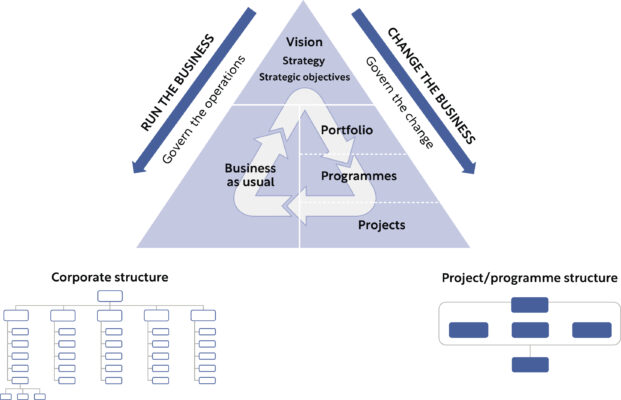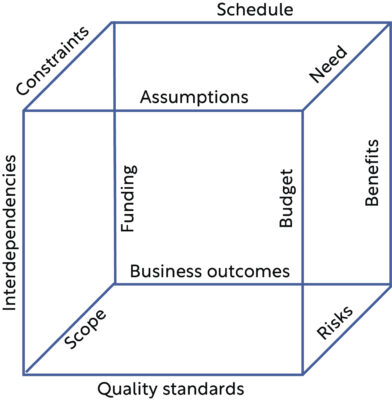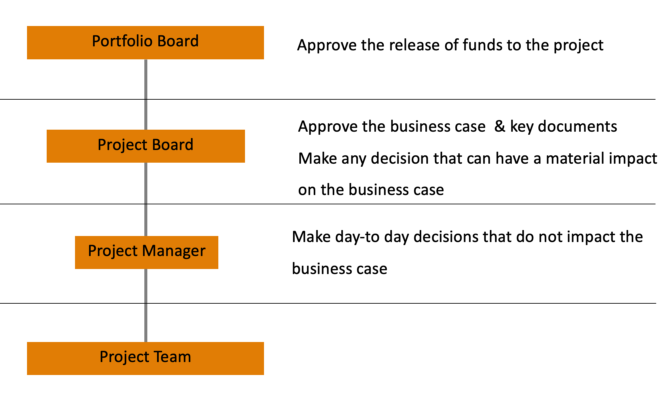What is project governance?
Project governance is the framework that enables effective project decision making. The focus is on key decisions that shape the project and its direction. It is made up of three core components.
The components of a project governance framework:
- The decision making structure
- The people within the structure
- The information that informs them
Why do I need project governance?
“Why can’t I run my project using the organisation structure?”
Because:
- The organisation structure is designed for business as usual (or BaU) decision making – not for projects.
- Projects have stakeholders scattered across the organisation and they need to be brought together for fast and efficient decision making
Business as usual versus change
- Another way to view this is to think of an organisation having two fundamentally different types of activity:
-Running the business – this is “business as usual”.
-Changing the business – using programs and projects to do so.
- The governance triangle on the next page displays this.
- The Governance Triangle shows that BaU needs to be governed differently to change (programs and projects).
BaU needs to be governed differently to projects
Step 1 – establish a single point of accountability
- A project should have ONE person accountable for its success.
- This person should remain constant over the life of the project.
- They should represent the business unit that will benefit from the project.
- This is NOT the Project Manager. The PM does not usually represent the business.
- This person is known as the Project Owner or (if you use PRINCE2) the Project Executive.
Step 2 – choose the right Project Owner
- It is important to choose the right Project Owner. Get it wrong and you’ll get the wrong project outcomes.
- Remember the project is there to deliver a business outcome.
- Therefore the Project Owner needs to represent the business.
- The Project Owner needs to be that role in the organisation that will use the project outcomes to meet their business needs.
- If you own a business outcome, you should own the project that will enable that business outcome.
- Business outcome ownership determines project ownership.
Step 3 – support the Project Owner with a Project Board
- The Project Owner needs the support of key project stakeholders.
- Stakeholders, sitting on a Project Board, may include representatives of:
– Those who fund the project (this will almost certainly include the Project Owner but there may be others).
– Those who use the products produced by the project (PRINCE2 refers to this role(s) as the Senior User).
– Suppliers to the project, perhaps both internal and external to the organisation.
- Too many stakeholders result in inefficient decision making. Try to limit numbers to around 6 for a project.
Step 4 – separate stakeholder management and project decision making
- What if you find you have 16 people on your Project Board?
- Your problem is that your Project Board has become a stakeholder management forum rather than a project decision making forum (which it should be).
- Not every stakeholder can be a member of the Project Board.
- Keep the Board to key stakeholders and form a “strategic advisors committee” for other stakeholders.
- Chair the strategic advisors committee with the Project Owner to give it credibility
Step 5 – separate project decision making and organisational decision making
- Remember we talked about separating business as usual and change?
- The Project Board needs to be able to make the key project decisions.
- If project decisions made by the Project Board are subsequently “ratified” or “endorsed” or “approved” etc by someone “higher up” in the organisation, then you haven’t successfully separated BaU and change.
- Hierarchical decision making slows down projects.
Step 6 – empower the Project Owner
The Project Owner, who is accountable for the success of the project, must be empowered. This means they must have:
- Decision making authority (see the previous slide).
- They must own the project budget because without budget ownership there is no real control.
- They must own the business case because the business case describes the investment they are making and what they want to get from that investment.
Alignment of accountabilities
- Reviewing what we have discussed, its clear there are a number of accountabilities that must be aligned for effective project governance.
- This is best displayed in the Accountability Equation below.
Step 7 – maintain the business case
The business case has two roles:
- To justify the investment being made in the project.
- To act as a governance tool for the Project Board.
- It contains the key parameters that define the project – drivers, expected outcomes, benefits, budget, schedule, quality standards, scope, funding, assumptions, interdependencies etc.
- If any of these are impacted, the Project Board need to know.
- In assessing any variation the Project Board must be able to assess how far the project has moved from it original intent.
- This means the history of changes to the project must be maintained.
The business case box
The Project Manager works inside the business case box.
As long as the boundaries of the box are not impacted, the Project Board need not be involved.
Only when the “shape” of the box is threatened does the Project Board need to make a decision. This is the essence of management by exception.
Step 8 – ensure consistent decision rights
- There may be many entities associated with the governance of a project.
- It is important that each decision making “layer” is clear on its decision rights. i.e. who makes what decisions?
- Clearly there should be no gaps.
- More important still is that there are no overlaps because this creates confusion.
- The next page gives a simple illustration for a project operating in an organisation with a portfolio board.
Example of consistent decision rights
Step 9 – document
- The governance arrangements should be documented.
- Ideally, each organisation should have a project governance policy (or, better yet, a capital investment policy).
- A capital investment policy should define:
– A risk based approach to governance.
– Decision rights of all parties.
– Roles and responsibilities.
– Terms of reference of committees.





